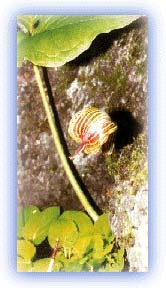Garhwal himalayas
General info
· Uttarakhand
· Eastern Garhwal
· Western Garhwal
Other Places of Interest
People
· Jaunsaries
· Jadhs
· Marchas
· Bhotias
Religion
· Gods and Goddesses
Flora and Fauna
· Wildlife

![]()
|
Uttarkashi Uttarkashi is another important city in the Garhwal region. It is the gateway to the pilgrim route to Gangotri. |
Central Himalayan foothills - a charm of their own. (Download Realplayer) |
 |
| Cobra Lily - an apt name. Credit: Raj Shirole |
Uttarkashi District was a part of the Tehri District till 1962. The beautiful small town is situated on the right bank of Bhagirathi at an altitude of about 1,550 m. The temples and ghats have names almost identical to those in Varanasi, a historical city in the Indian plains. The most important temple dedicated to Shiva is known as Vishwanath Mandir, where stands a magnificent Trishul (trident), one meter in circumference and made of copper. It supports a trident four meters long. Each prong is about two meters in length. Uttarkashi is known for its temples dedicated to Parhsuram, Datatryea, Annapurna, Devi, Kali Bhairon and other gods and goddesses. At one time, there were 365 temples in this town.
Uttarkashi is also known as Barahat, literally meaning "a big market place". In olden days Kedarnath was a 12 days' trek away, Gangotri 7 days, Yamunotri 5 days and Srinagar 6 days away. Nowadays, motorable roads go to most of these places.
Uttarkashi also has a number of ashrams for the sanyasis and mendicants who occupy the banks of the holy river for penance and prayers.
It is a modern town with facilities. The Nehru Institute of Mountaineering is located here. It is situated at a spur at Ladari, dominating the beautiful town and overlooking the entire valley. This national institute imparts mountaineering training to young people to inculcate the spirit of adventure among the youth of the country. The institute at Uttarkashi is the second Nehru Mountaineering Institute which conducts basic and advanced mountaineering courses. Uttarkashi has developed rapidly due to the construction of the Maneri Valley Hydroelectric Project.
Generally, it is a moderate society in which economic differences are not so marked, and therefore, there are far less social disparities in comparison with societies in the more developed parts of the country. Social distinction does exist however, on the basis of the caste structure.
All rights reserved